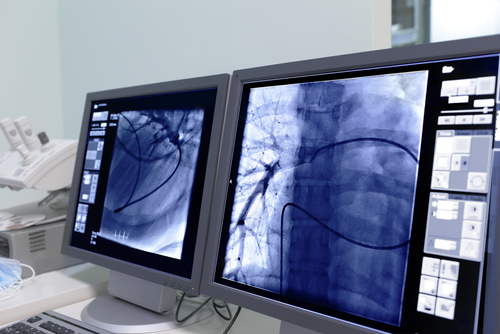 Netherlands based multinational manufacturer of Healthcare, Consumer Lifestyle and Lighting products Royal Philips this week unveiled at the 2014 Radiological Society of North America (RSNA) Annual Meeting in Chicago this week a new lung screening solution that it says is designed to give health care providers a faster, more definitive option for lung cancer detection and treatment. This diagnostic solution is a comprehensive package of products and services that facilitate implementation and management of a computed tomography (CT) lung screening program for tracking and guiding patients across the health care continuum.
Netherlands based multinational manufacturer of Healthcare, Consumer Lifestyle and Lighting products Royal Philips this week unveiled at the 2014 Radiological Society of North America (RSNA) Annual Meeting in Chicago this week a new lung screening solution that it says is designed to give health care providers a faster, more definitive option for lung cancer detection and treatment. This diagnostic solution is a comprehensive package of products and services that facilitate implementation and management of a computed tomography (CT) lung screening program for tracking and guiding patients across the health care continuum.
Philips notes that having diagnostic confidence is always the goal, and that with today’s value-based reimbursement structures and demand for improved clinical outcomes, it’s a necessity. Ideally, each step of the diagnostic process should provide quality actionable results — the operative axiom being “the right test at the right time.”
 “Philips has long been at the forefront of offering sophisticated solutions for early detection of a wide range of conditions, but today’s clinicians need to integrate all relevant information quickly to reach a definitive diagnosis,” says Philips executive vice president and CEO of Imaging Systems Gene Saragnese in a release. “Philips is in a unique position to be able to offer not only the advanced imaging technology to make early lung cancer detection possible, but the data insights, collaboration and education tools that are needed to deliver the quality and consistency required for health systems to succeed in new, evidence-based models of patient care.”
“Philips has long been at the forefront of offering sophisticated solutions for early detection of a wide range of conditions, but today’s clinicians need to integrate all relevant information quickly to reach a definitive diagnosis,” says Philips executive vice president and CEO of Imaging Systems Gene Saragnese in a release. “Philips is in a unique position to be able to offer not only the advanced imaging technology to make early lung cancer detection possible, but the data insights, collaboration and education tools that are needed to deliver the quality and consistency required for health systems to succeed in new, evidence-based models of patient care.”
In common with all cancers, early detection is key to surviving lung cancer. The 2011 National Lung Screening Trial (NLST) revealed that low-dose computed tomography (CT) screening resulted in a reduction in lung cancer mortality by 20 percent among a population of current or former heavy smokers who were screened with low-dose helical computed tomography (CT) versus those screened with chest X-rays as the diagnostic medium, according to primary research results published online by the New England Journal of Medicine. Moreover, Philips notes that this patient cohort is particularly challenging to track and manage due to a high volume of measurements, data and changes in tumor and patient status over time.
Scientists have found a 20 percent reduction in deaths from lung cancer among current or former heavy smokers. The primary research results from the National Lung Screening Trial (NLST) were published online today in the New England Journal of Medicine.
Philips’ new lung screening solution solution is compatible with most low-dose CT scanners, consisting of an integrated portfolio of products and services that together offer a complete program to health care providers for early lung cancer detection and easy assessment of individual patient status in addition to overall program key performance indicators.
[adrotate group=”3″]
 “Lung cancer has a significant mortality rate in the U.S., and given the large number of heavy smokers in the aging baby boomer population, we can expect to see that number rise in the coming years,” says Dr. Andrea McKee, MD, chair of the Radiation Oncology Department at Lahey Hospital and Medical Center in Burlington, MA. “Philips’ innovation in lung screening aligns with the industry’s focus on preventative screening and taking a more holistic approach to patient care.”
“Lung cancer has a significant mortality rate in the U.S., and given the large number of heavy smokers in the aging baby boomer population, we can expect to see that number rise in the coming years,” says Dr. Andrea McKee, MD, chair of the Radiation Oncology Department at Lahey Hospital and Medical Center in Burlington, MA. “Philips’ innovation in lung screening aligns with the industry’s focus on preventative screening and taking a more holistic approach to patient care.”
The Philips solution’s several elements synergistically allow health care providers to enhance lung cancer screening and management speed and accuracy with decreasing the overall lung cancer mortality rate.
Built-in consultative services and marketing support enables clinicians to address the needs of high-risk patients and their primary care physicians (PCPs), supply patient advocacy and support organization connections, provide information sources, and access to marketing materials for lung cancer screening services.
Patient Management
“Control center” software helps providers to implement a package of customized clinical protocols that also enable establishment of interfaces with other hospital systems (HIS, RIS, EMR and PACS), thus providing clinical teams with 360-degree patient profiles. The product’s customizable workflow tools also push timely, accurate notifications, while tracking participant history and touch points.
Radiology Workflow
The program’s CT lung image review and reporting feature uses specialized radiology software tools that facilitate serial CT lung exam review and reporting to identify and easily follow up on areas of concern identified.
Physician Education Resources
A comprehensive online education portal measures and reports on radiologist performance against a wide ranging clinical case database, as well as providing convenient access to structured education courses and other reference materials.
The Philips lung screening and management system will be available in North America in the first half of 2015, and will be showcased in booth #6742 at the Radiological Society of North America Annual Meeting (RSNA), being held November 30th through December 5th in Chicago, Ill. For more information, visit: http://www.philips.com/rsna and follow @PhilipsHealth for more information on Philips’ presence at #RSNA14.
For more information on Philips innovative imaging systems that focus on the health continuum from prevention, screening and diagnosis, to treatment, recovery and home care, visit:
http://www.philips.com/healthcare
Sources:
Royal Philips
Image Credits
Royal Philips
Lahey Hospital and Medical Center


